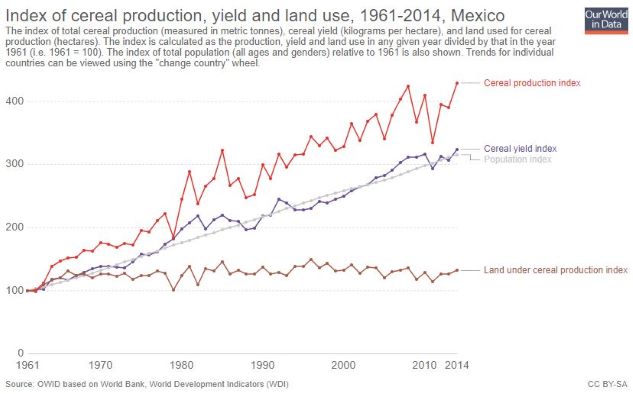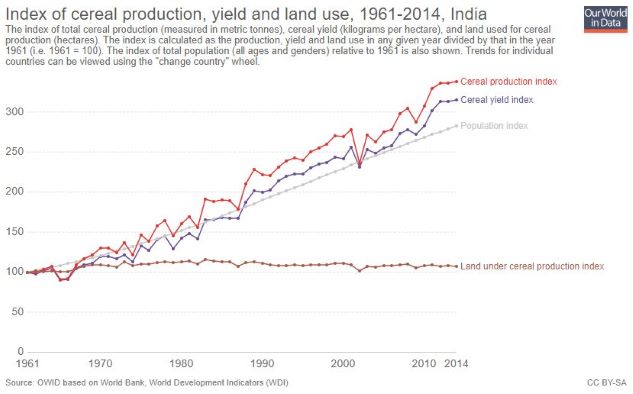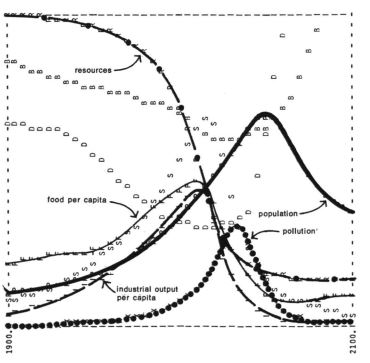Written by Ryan McGuine //
Today the world produces historically spectacular amounts of food. Despite this, around 12% of the world remains undernourished, and assuming current trends hold, the world’s population is projected to reach 9.8 billion people around 2050 and 11.2 billion by 2100, making the challenge of keeping everyone well-fed even more difficult. Technological progress has enabled the huge crop yields of today, but how to continue that yield growth, and whether that is the best way forward, remains uncertain. Acknowledging the importance of food security, the UN chose “Zero Hunger” as the 2nd Sustainable Development Goal.
For much of prehistory, humans met their caloric needs by foraging and hunting. However, around 10,000 years ago some populations began managing wild plants and animals, which eventually led to their domestication and the beginnings of traditional agriculture. There is no precise reason for the move to agriculture, and it probably arose from a combination of interdependent natural and social interactions. The diffusion of agriculture increased the productivity of land and enabled societies to accumulate a resource surplus. In turn, this surplus helped reduce the pressures of population growth and environmental stress, while allowing people to remain in one place, have larger families, and organize for their common defense.
Thomas Malthus published his treatise An Essay on the Principle of Population in 1798, which asserted that the dynamics of population growth and of food production would eventually erode the world’s ability to feed itself. Over time, according to Malthus, the rate of population growth and rate of increased well-being would constrain one another sufficiently to prevent either from increasing permanently. While Malthus’ claim may sound outlandish today, it is worth remembering that the standard of living in London during his lifetime was scarcely better than during the Roman Empire. The intensification of traditional agriculture was mostly limited to more efficient uses of animal labor, irrigation advances, some increased fertilization, and the adoption of crop rotation practices.
In 1843, Justus von Liebig worked out that of the three macronutrients required in large quantities for agriculture (nitrogen, phosphorus, and potassium), the nutrient in shortest supply will determine the yield. Even though nitrogen is abundant in air, it has proved the most challenging of the three to provide in the quantities necessary, and in a form that could be applied to fields. During the late nineteenth century, it was beginning to look like Malthus was correct. Despite some modest agricultural intensification, farmers were having a difficult time producing enough food for a rapidly-growing population. In 1909, however, Fritz Haber discovered a high pressure reaction between natural gas and air to synthesize ammonia, a compound rich in nitrogen. Later commercialized by Carl Bosch at BASF, the Haber-Bosch process is now responsible for the majority of the world’s nitrogen fertilizer, and its implications have proven nothing short of miraculous — in its absence, today’s diets would contain nearly 40% fewer calories.
Modern agriculture is characterized by the use of fossil fuels to power mechanized cultivation and as feedstocks for various fertilizers and protective agrochemicals, the use of high-yielding varieties of cereal crops, and massive irrigation. During the mid-20th century, there was a clear divide forming in food production — about half of all Asians lived in hunger, and crop yields in many developing countries were stagnant, while modern agricultural techniques were steadily increasing yields in their industrialized counterparts. In an effort to address this widening gap, the Rockefeller and Ford Foundations funded a set of initiatives during the 1950s-80s known as the Green Revolution. Over the course of just a few decades, Mexican wheat farmers were able to harvest up to 10 times as much wheat from their fields, and Asian rice yields nearly tripled.


The widespread proliferation of this type of modern, intensive agriculture has proven to be an important factor in the overall process of industrialization in that it increases the productivity of the agricultural sector, which nudges agricultural productivity toward convergence with that of higher-productivity sectors. This frees up labor to work in higher-productivity sectors, boosting the economy’s overall productivity — the main driver of economic growth. Additionally, a dynamic agricultural sector drives the development of other sectors via backward linkages to manufacturing and financial and legal services, as well as forward linkages to transportation and logistics services.
Following a Malthusian line of reasoning, an informal international association of scientists, economists, and civil servants known as The Club of Rome published a report titled The Limits to Growth in 1972. The report alleges that exponential growth of both population and capital is impossible on a planet of fixed resources. According to The Club of Rome’s business-as-usual model, seen in the plot below, food, industrial output, and population grow exponentially until the rapidly-diminishing resource base forces a slowdown in industrial growth. Eventually, population growth is halted by a rise in the death rate due to the slowed provision of food and medical services. The Club of Rome suggested that this could be avoided only by stabilizing both population growth and capital growth.

Source: The Club of Rome (2018), The Limits to Growth
However, pointing to problems like these as evidence that growth ought not be pursued is flawed. As Tyler Cowen argues in his book Stubborn Attachments, the wealth created by sustainable economic growth — defined by Mr Cowen as the rate of GDP per capita growth, modified to weigh difficult-to-measure variables like environmental impact, leisure time, and household production more heavily — will alleviate most abject suffering. Indeed, economic growth enables the flourishing of a plurality of values, including justice and beauty, and most important to humanity’s ability to overcome natural constraints, applied scientific research.
Originally formulated by Simon Kuznets to show that inequality tends to increase, then decrease with rising levels of personal income, Kuznets Curves can be used to describe many negative environmental phenomena. This suggests that not only is economic growth not the problem, it is the key to addressing the concerns raised by the Club of Rome.
Today, the main concern associated with food security has to do with the distribution of food, not its production. As Amartya Sen points out in Development as Freedom, famines rarely affect an entire population. Rather, they are the embodiment of severe inequalities in entitlements — the relative inability of a group to acquire food in the market. All four countries currently facing UN-declared famines are conflict zones, resulting in disruptions to food systems, as well as large differentials in the availability of social services across populations. Regions in the USA where shortages of nutritious food are prevalent, known as “food deserts,” are disproportionately located in disadvantaged neighborhoods. Broad economic mismanagement by the Venezuelan government led by Nicholás Maduro has cruelly resulted in an environment of scarcity for most Venezuelans, while the wealthiest have the monetary and political ability to acquire food on the black market.
Even though innovations may have enabled the world to feed itself for the time being, modern agriculture places significant stress on the environment, generating negative externalities. For example, large-scale irrigation is draining some aquifers faster than they are can be replenished, fertilizer and protective agrochemical runoff is creating large aquatic dead zones, and fertile soils are being depleted of nutrients over time. Despite these externalities, farmers will need to find ways to boost total output by 50-100% by 2050.
In his book The Wizard and the Prophet, Charles C Mann uses William Vogt and Norman Borlaug to personify the ongoing dispute between “apocalyptic environmentalism” and “techno-optimism.” Of course, the most vocal proponents of any ideological movement tend toward the extremes and one should be wary of sweeping claims, particularly when the system is as complex as the earth’s resource flows. More technological solutions will probably need to be adopted in order to increase yields, but so too will mitigation of environmental harm probably be needed. Methods for reducing agriculture’s footprint on the environment include growing more food on land currently under cultivation, using inputs like fertilizer and water more efficiently, shifting diets away from the most resource-intensive types of meat, and reducing food waste. Further, policies that facilitate sustainable economic growth, paired with the enhancement of political and social agency for disenfranchised populations, can help ensure an equitable distribution of food. There is no one silver bullet solution for feeding the world, but rather a wide array of partial solutions that should be pursued concurrently.
